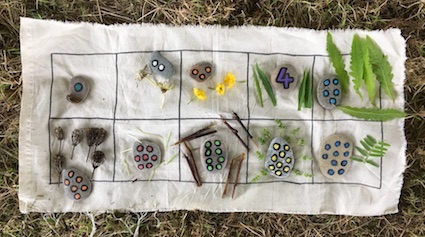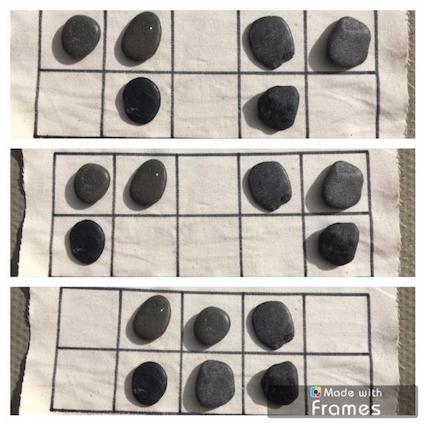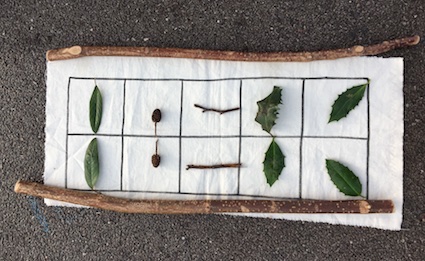Ten frames have has a surge in popularity in recent years as greater awareness grows about the need for children to have time exploring maths concepts using concrete materials. Thinking, reasoning and realising the patterns that objects make which can be linked to our number system are all part of the attraction of a ten frame. In particular, ten frames help developing an understanding of place value. A useful brief overview can be found here to this effect.

Naturally I have been exploring the outdoor potential of such a nifty little resource. My issue is that I don’t really like being bogged down with loads of stuff. So remembering cardboard or egg carton ten frames on top of other paraphernalia is a bit much for my weight-sensitive feelings.
To this effect, I’ve had the joy of using a ten frame which can be folded up and kept in a pocket – thanks to permanent mark pens and calico cotton, I’ve been able to do a wee cottage industry creating these. After various experimentations, I’ve come to prefer a 20cm x 50cm frame which strikes a nice balance between being too small to fit found objects onto and too big to be cumbersome.
There is something quite magical about taking a little white bit of cloth out of your pocket and presenting it to children. The reverse is blank so equally useful when no lines are needed for games, art work and so on. One of the nicest things to do is to leave the ten frame somewhere outside and simply encourage children who find something interesting to place it in the frame and see what treasures are found. More often than not, the ten frame is moved or becomes used in a non-mathematical way as the children play and find different uses for it.
From a mathematical perspective it is helpful to encourage children to place one object into one square. If this doesn’t happen, then it can become a teaching point when you gather children or when you next bring out a ten frame (e.g. with modelling of what wish to see and wondering aloud how children will remember this). This can help identify any misconceptions – such as illustrated in the above photo – which can be addressed. With regard to this photo I should point out, that in the activity where this layout was created, the group was simply asked to explore the maths resources. The ten frame in this situation was not used in the way it was intended but just as a focal point to create the matching game. I often meet children and educators who are unfamiliar with a ten frame, especially when I was working abroad.
In my experience children and adults alike need time to explore and be creative with the resources I make available prior to being formally taught an aspect of maths that uses these resources. Most of my kit is unfamiliar. One of the most interesting investigations I witnessed was from a seven-year old who observed whenever he moved his collection of six stones, the number of stones always remained at six and the number of blank spaces were always four. This is a lovely demonstration that this child was learning about conservation of number and how the number of objects was not affected by their layout.

Naturally this can lead on to exploring the range of “pattern of six” that can be created on one ten frame. The photos don’t show the complete range (and please note the wee word pun – I used the Frames app to create the collages).

This type of comment can lead into exploring other number pattern variations. For example, is there a link between the number of layouts which each number can make?
It’s also interesting from a subitising perspective. Very often children can quickly learn to recognise the standardised layouts such as Numicon – but struggle to subitise when the objects are presented in different – and often non-standard ways – that is typically found in the real world. Try it and see. Karen Wilding’s resources and professional development are helpful here. Likewise Christopher Danielson’s book How Many? and his website are worth checking out.

You can see from the pattern above that a ten frame works for symmetry explorations as a very basic grid that supports spacing of objects. Once child can create a line and his or her partner has to find and copy the layout of the objects. The level of accuracy expected can depend upon the ability of a child.
Finally an interesting activity outside is to ask children to develop their own maths games and activities around the use of a ten frame. What ideas do your children have? Have they encountered a ten frame previously and know some of the expectations around using it in a maths context? When children are doing this, it is helpful to be aware of what children know about the mathematical purpose of a ten frame.
Environmental and sustainable matters around the use of cotton tens frames
Since the publication of this original post in October 2017, tens frames have grown in popularity for their outdoor potential. It is always worth considering, not just weight issues but the environmental and social responsibility of resourcing.
- Re-use unwanted items: egg boxes, bedding plant containers, old ice cube trays, worn pillowcases (for the cotton ten frames) and so on. This can help children realise the mathematical potential of everything as well as making best use of everything.
- If you must buy ten frames resources, think about the source and supplier and the environmental and ethical footprint of the resource.
- Cotton ten frames are designed for easy use and that includes washing them. However try not to be obsessive about this as they will get muddy the moment they are used outside again. Just don’t leave them wet and damp. That’s when they become mouldy and smelly. If you are really organised, then finish the sides by stitching. I’ve also seen people stitch the actual ten frame pattern. I did try using serrated scissors to finish the edges but these go awry when the material gets washed.




















I really like this idea, so much open ended potential. I’d like to make some of these though I’m not very crafty- what’s the difference between calico cotton and other cotton- also where do you source it?
Hi Becci
Thanks for your comment. Calico cotton is unbleached cotton and unfinished and without dyes. It comes in various weights and I tend to go for the lighter weight where a choice exists. You can buy it from almost any haberdashery store or textile department. It’s used in a lot of cotton shopping bags.
Hope this helps.